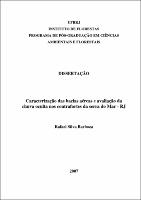Please use this identifier to cite or link to this item:
https://rima.ufrrj.br/jspui/handle/20.500.14407/11263| Tipo do documento: | Dissertação |
| Title: | Caracterização das bacias aéreas e avaliação da chuva oculta nos contrafortes da Serra do Mar - RJ |
| Other Titles: | Characterization of the air basins and fog interception evaluation in the backstrongs of mountain range of Mar |
| Authors: | Barboza, Rafael Silva |
| Orientador(a): | Valcarcel, Ricardo |
| Primeiro coorientador: | Pereira, Carlos Rodrigues |
| Primeiro membro da banca: | Oliveira, Jorge Luiz Fernandes de |
| Segundo membro da banca: | Mello, Jorge Luiz Pimenta |
| Keywords: | fog interception;hydrology resources;air basin;chuva oculta;recursos hídricos;bacia aérea;Mata Atlântica;serra do Mar;Atlantic Forest;mountain range of Mar |
| Área(s) do CNPq: | Recursos Florestais e Engenharia Florestal |
| Idioma: | por |
| Issue Date: | 27-Jun-2007 |
| Publisher: | Universidade Federal Rural do Rio de Janeiro |
| Sigla da instituição: | UFRRJ |
| Departamento: | Instituto de Florestas |
| Programa: | Programa de Pós-Graduação em Ciências Ambientais e Florestais |
| Citation: | BARBOZA, Rafael Silva. Caracterização das bacias aéreas e avaliação da chuva oculta nos contrafortes da serra do Mar - RJ. 2007. 61 f. Dissertação (Mestrado em Ciências Ambientais e Florestais) - Instituto de Florestas, Universidade Federal Rural do Rio de Janeiro, Seropédica - RJ, 2007. |
| Abstract: | A Bacia Aérea é um espaço tridimensional que conduz e distribui os ventos sobre as bacias hidrográficas. No Estado do Rio de Janeiro, 48% do território é composto pela vertente Atlântica, onde foram registradas 16 bacias aéreas com características ambientais específicas, distribuídas em 20% da área. Baseado na conformação de parâmetros morfométricos as bacias aéreas foram agrupadas, através de Análise Multivariada – Cluster, com distância Euclidiana de 48%, nível de significância de 95% e coeficiente de correlação de 0,7132 em 5 grupos com formas similares. Para avaliar os efeitos hidrológicos dentro das bacias aéreas, utilizou-se como estudo de caso a bacia aérea de Angra dos Reis, onde a magnitude da variável interceptação das nuvens foi medida na zona de escape, a partir do interflúvio da bacia hidrográfica do rio Pirai (sotavento), em distâncias de afastamento distintas, com e sem barreiras orográficas, durante o inverno e verão. Utilizou-se área amostral de interceptação vertical equivalente a 0,45% das florestas da região. A variação do afastamento do interflúvio ocorreu até desnível de 500 m em altitude, podendo ser este limite o fim da zona de escape e início da zona de distribuição da bacia aérea. O efeito da bacia aérea representou adicional de 44% em volume de chuva no interflúvio (ponto 1), 39% a 4,5 km (ponto 2) e 42% a 7,5 km (ponto 3) do ponto 1 em direção concordante ao sentido do fluxo. O efeito da orografia no corredor variou de forma irregular no inverno e no verão, mantendo diferencial de 23% e 77% no ponto A (obstrução de 85% da seção transversal) e 32% e 68% , no ponto B (obstrução de 80% da seção transversal). Em áreas sob influência de bacias aéreas, as variáveis e processos ambientais podem ser determinantes para ofertar serviços ambientais nas bacias hidrográficas. |
| Abstract: | The air basin is a three-dimensional space that conduct and distribute the winds over the drainage basin. In Rio de Janeiro’s state, 48% of the territory is constituted by Atlantic slope, where were registered 16 air basins with specific environmental features, distributed in 20% of the area. Based on the conformation of morphometrics parameters the air basins were grouped, by Multivariate Analysis - Cluster, with Euclidean distance of 48%, significance level of 95% and correlation coefficient of 0.7132, in 5 groups with similar forms. To evaluate the hydrologic effects within the air basins, it was used as a study case, the air basin of Angra dos Reis, where the magnitude of the interception of clouds was measured in the escape zone from the topographic divide of the Pirai river basin (leeward), in different distance away, with and without natural barriers, during the winter and summer. It was used vertical intercept sampling area equivalent to 0.45% of the forests in the region. The variation of the removal of the topographic divide occurred until 500 m of altitude, this limit may be the end of the escape zone and the beginning of the air basin distribution zone. The effect of air basin represented additional of 44% of the volume of rain in topographic divide (point 1), 39% at 4.5 km (point 2) and 42% at 7.5 km (point 3) of the point 1, in concordant direction of the flow. The effect of the orography in the trajectory of the winds, varied in an irregular way in winter and in summer, maintaining differential of 23% and 77% in point A (obstruction of 85% of the cross section) and 32% and 68% in point B (obstruction of 80% of the cross section). In areas under the influence of air basins, the variables and environmental processes can be crucial to offer environmental services in drainage basins. |
| URI: | https://rima.ufrrj.br/jspui/handle/20.500.14407/11263 |
| Appears in Collections: | Mestrado em Ciências Ambientais e Florestais |
Se for cadastrado no RIMA, poderá receber informações por email.
Se ainda não tem uma conta, cadastre-se aqui!
Files in This Item:
| File | Description | Size | Format | |
|---|---|---|---|---|
| 2007 - Rafael Silva Barboza.pdf | Rafael Silva Barboza | 2.01 MB | Adobe PDF |  View/Open |
Items in DSpace are protected by copyright, with all rights reserved, unless otherwise indicated.

